The sights, smells and taste of Chhath
Be it Houston or Hazaribagh, the Chhath Puja celebrations have a comforting sameness to it with special rituals, foods and songs that worshippers bring to it with great devotion. Gaon Connection presents special food recipes associated with each day of the four-day long Chhath celebrations. Cook, share and savour them.

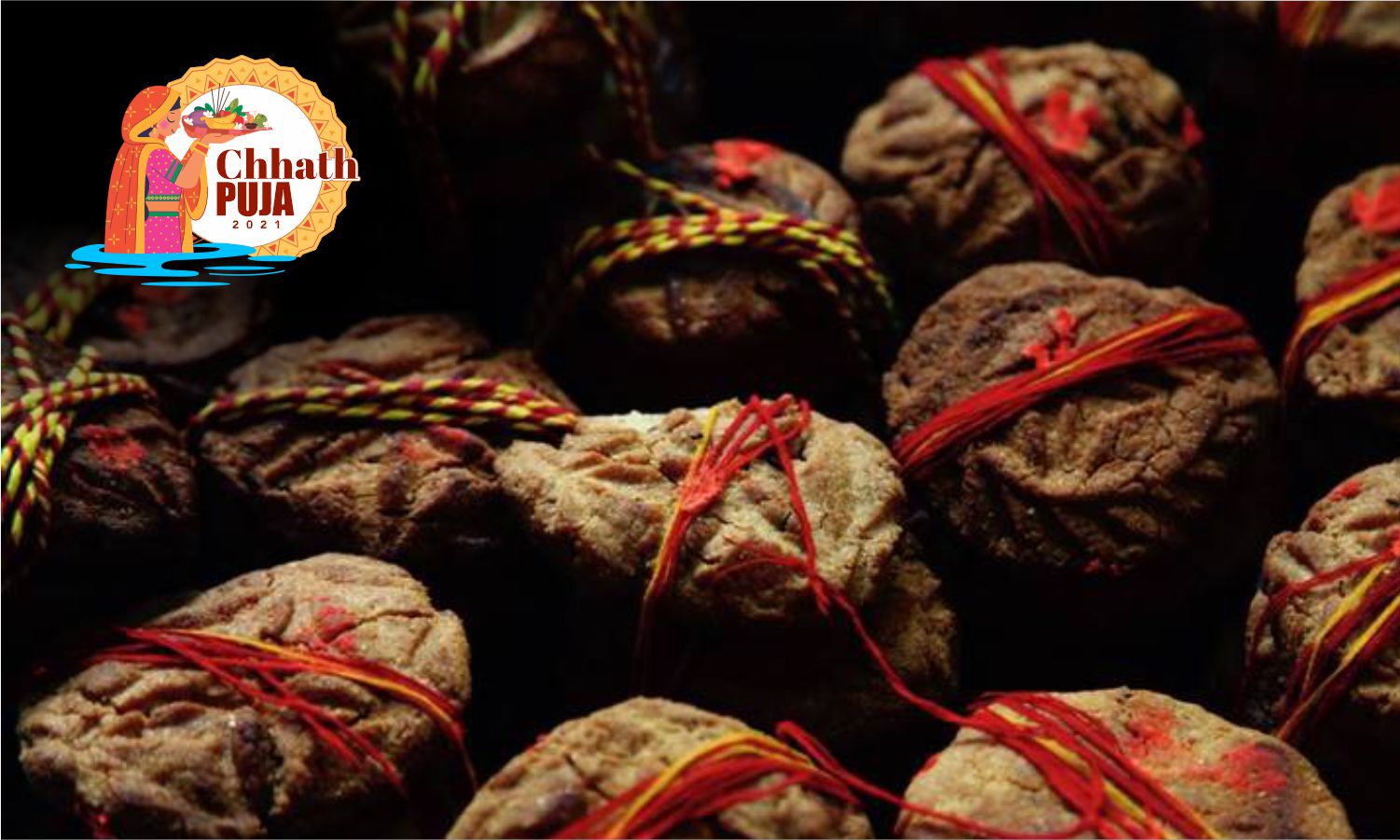
Thekua, a traditional Bihari cuisine. Photo: Eklavya Prasad
Festivities are in the air as Chhath is being celebrated in Bihar, Jharkhand and parts of Uttar Pradesh. Today, November 10, is the third day of the four-day long festival dedicated to Surya Dev (Sun god) and Chhathi Maiyya.
The preparations for Chhath start soon after Diwali in the month of Kartik. The prayers begin on the fourth day after Diwali and conclude with arghya to the rising Sun on the seventh day.
As it is with Indian festivals, Chhath too comes with its complement of special foods. The dishes are sattvik (without onion, garlic and spices), and each day of the Chhath festival has a different menu.
Gaon Connection documents some of these special recipes, which you can try your hands at as you participate in the Chhath Puja with your family and friends. Apart from having ritualistic significance, these food items also have several health benefits.
Also Read: In Photos: From Nahay Khay to arghaya — how people in Bihar and Jharkhand celebrate Chhath Puja
Day 1: Nahay Khay
The first day of Chhath Puja falls on the fourth day after Diwali and is called nahay-khaay (bathe and eat). The devotees take a dip in a river if there is one near them, or sprinkle Gangajal. The vrati (one who fasts) has to use a datun (neem stem used as a toothbrush).
Folk singer Sharda Sinha, who has sung several Chhath songs, told Gaon Connection that she remembers walking long distances in her in-laws’ village in Patna district of Bihar to fetch the holy water in brass pots from the Ganges, along with others who were fasting.
After the bath, devotees prepare kaddu-bhaat (bottle gourd with rice), and have it after offering it to the deity.
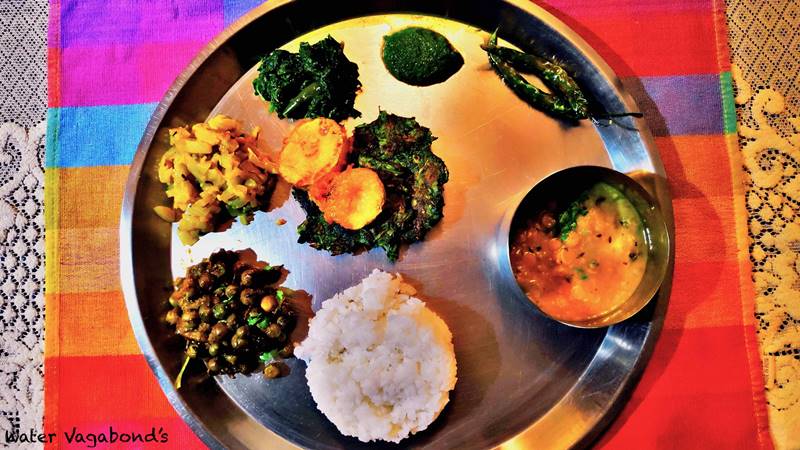
“In Mithilanchal, it is called arwa-arwain because only arwa rice is used. The meal holds significance for a vrati or parvatin or worshipper. It is a preparatory step before embarking on a fasting journey of 36 hours,” said folk singer Sinha. According to her, such a meal cools the stomach, tempers the taste buds, and purifies the digestive system.
Also Read: A folk-singer, a filmmaker and an actor from Bihar share their memories of Chhath
People also cook chana dal (split chickpea lentils), while in some households moong dal (yellow lentils) is prepared. In some places, bottle gourd is prepared along with split chickpea lentils.
After eating on nahay-kahaye, sometime around noon, the vrati starts the nirjala or the waterless fast.
Day 2: Kharna
The second day of Chhath is known as Kharna or Lohanda. On this day, devotees break the fast after sunset. They cook kheer-roti (rice pudding made with jaggery and chapatis smeared with ghee) or poori on the clay stove and offer it to the deity on a banana leaf, along with bananas.
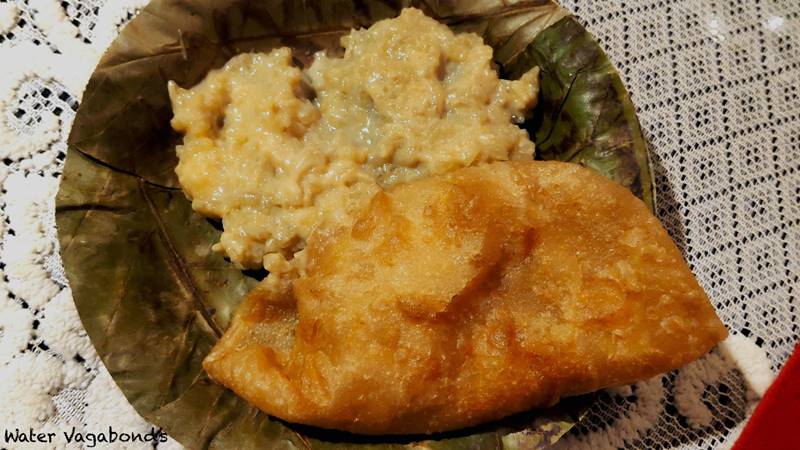
“The vrati has to eat the prasad in silence. Once the vrati has eaten, the prasad is distributed to others in the household and in the neighbourhood. It is the only meal to be had that day. The fast starts after Kharna and it is broken on the last day of Chhath, after arghya,” said Sinha.
Also Read: On Jur Sital, the Maithili New Year, the chulha maharani gets a break
The one who fasts stays awake through the festivities and can sleep only on the ground. “I remember collecting pual (dried, yellowed stalks from crops) from the fields for my mother. It gave warmth during the winter night so that she could rest for a while, and prepare for the arduous day that lay ahead,” recalled Amrendra Sharma, an actor from Pashchim Champaran in Bihar.
“Where pual isn’t available, a blanket is put on the floor as wool is considered pure,” Kamakhya Narayan Singh, the Guwahati-born filmmaker from Mumbai, told Gaon Connection. Singh now uses a stove instead of a clay chulha to cook Kharna prasad in Mumbai. He has been observing the Chhath fast for the past five years now.
Day 3: Sandhya Arghya
The third day of Chhath Puja is the main day of the festival. It is spent preparing khasar (small balls made from rice flour and jaggery) and thekua (made from jaggery and wheat flour) to be offered to the deity.
“The wheat flour used for thekua is coarse. We have places in Mumbai where the machine is thoroughly cleaned, before the wheat is ground for Chhath,” said Singh.

Also Read: Deepavali and lehyam love
Meanwhile, folk singer Sinha narrated how the vrati stayed awake at night singing songs and making the prasad. “The work used to start at midnight after Kharna in some households. The vrati has to stay awake, so this helps her do that,” she added.
Once the prasad is prepared, the daala (festive offering for the deity) is readied for the evening arghya. Chhath daala is the offering of seasonal fruits and vegetables to the deity. “These include turmeric, ginger, sweet potato, radish, yam; gram and pea, water chestnut, sugarcane, gagra nimbu (lemon), coconut with husk and water, banana, custard apple, and dry fruits,” Ravi S Sahani, Patna-based photographer, told Gaon Connection.
Some people offer arghya in a brass soop, while others use a bamboo soop; both are considered pure. “People also buy a clay elephant that comes with a big diya (earthen lamp) fixed atop it for Chhath Puja. The red/pink aarta patra made from the akwan plants is a must for Chhath. Local artisans make them,” he added.
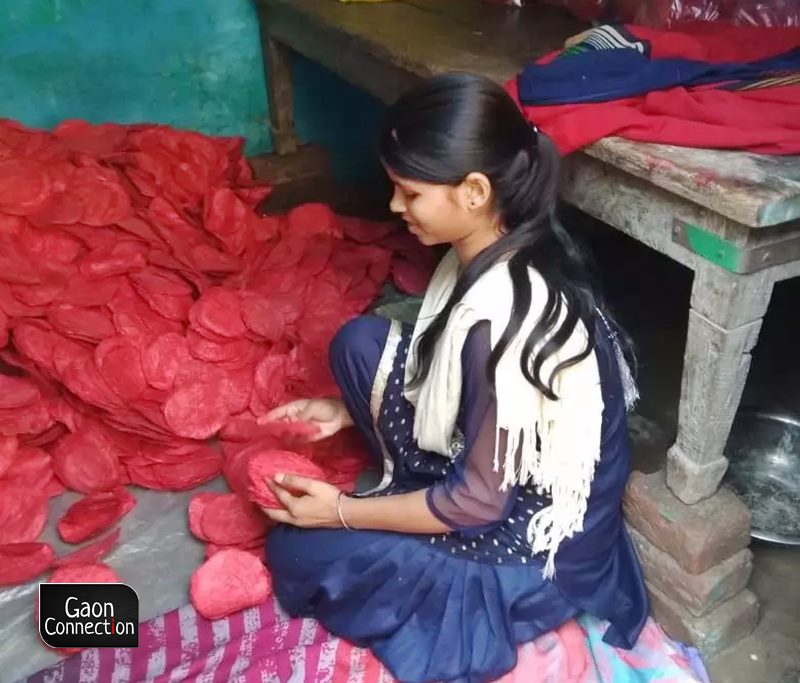
The beautifully decorated soops with the sweets, water, milk and earthen lamps, are taken to a water body, where the vrati in new clothes stands knee-deep in water and offers them to the setting Sun. “Those who stay in the city like me and can’t go to a water body to offer arghya, do it on their terrace,” explained filmmaker Singh.
Also Read: Puthandu Vazhuthugal: Neem flowers, jaggery and raw mangoes on Tamil New Year
Day 4: Usha Arghya
The last day of Chhath Puja starts soon after midnight when the vrati prepares the parna (meal to break the fast), and then readies the soop afresh.
At dawn, the vrati once again makes the offering to the Sun god and this marks the culmination of the festival.
According to folk singer Sinha, people break their fast with sharbat (juice), sprouted grains, cucumber, and prasad. “All these have a cooling effect on the stomach that has not received food for 36 hours at a stretch. These foods are light for a vrati to digest,” she said.
This is followed by a full course meal that includes rice, dal, green veggies, including bachka, tarua and tilkor. “We also prepare fritters. And serve them with curd and chutney. The food is meant to tickle a vrati’s taste buds,” the folk singer added.
Also Read: Vocal For Local: An alliance with millets

Singh breaks his fast with thekua, jaggery and warm water. He said he always looked forward to the feast that followed. It includes kadhi-badi (a traditional blend of a spiced and creamy yoghurt curry or kadhi which is served along with crispy chickpea flour fritters), kohda (pumpkin), ole (Elephant Foot or yam) and aloo-gobhi (potato-cauliflower) vegetables besides fritters with a generous helping of rice.
In some homes the vrati breaks the fast with ginger and warm water, followed by vegetarian meal and then fish curry and rice that is considered a good omen like it is in actor Sharma’s home.
“The vrati break the fast with ginger and warm water, followed by tea. We prepare vegetarian delicacies, but it is mandatory to have fish and rice by the vrati that day,” he said.
This last feast sees the conclusion of the Chhath celebrations, till the following year.
Happy Chhath! Jai Chhathi Maiya!
Chhath Food Recipes
Thekua
Ingredients:
Jaggery (500 g)
Coarse wheat flour (1 kg)
Fennel seeds
Water
Heat a little water in a pan, add jaggery to it so that it dissolves. To check the consistency of the mixture, dip your index finger and using your thumb, stretch that drop to see if it makes threads or not. The proportion of jaggery and flour is 1:2. The jaggery shouldn’t make threads.
Add fennel seeds and jaggery syrup to the dough, and knead it hard. Ghee (clarified butter) doesn’t have to be added to flour if it is for the deity, but otherwise, feel free to add ghee to make the thekuas crispy.
Make small balls of the dough, flatten them on the thekua mould, and press. The imprint gives it a dash of festive flavour.

Deep fry it in ghee (for puja) or refined oil (otherwise) in a kadhai till deep brown. Keep the fried ones on a paper napkin or cloth napkin for the oil to drain, and it is ready to serve.
Kohda ki Sabji
Ingredients:
Pumpkin (500 g)
Panch phorna, which is an aromatic blend of five whole seeds — jeera (cumin), methi (fenugreek), kalonji (nigella sativa), saunf (fennel) and rai (mustard)
Ghee 2-3 tbsp
2-3 dried red chillies
Salt a pinch
Jaggery or sugar (not more than 20 g)
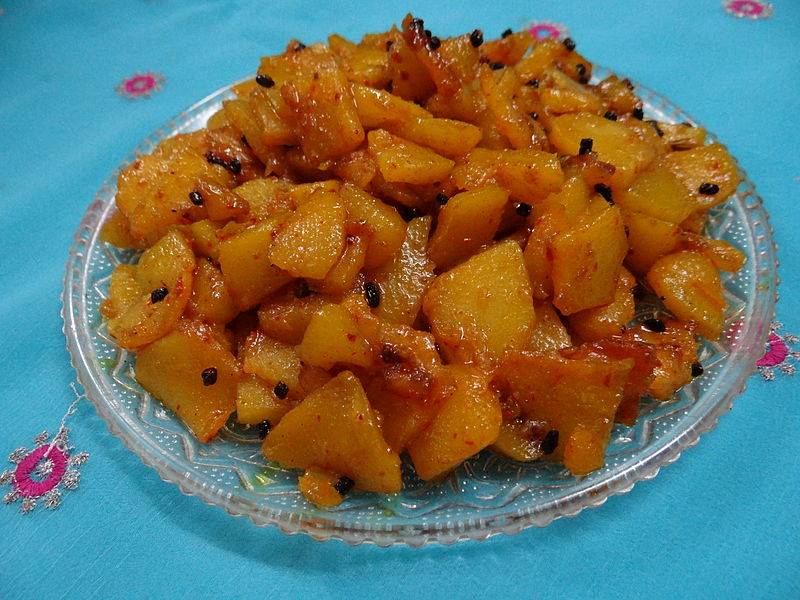
Cut the pumpkin lengthwise without peeling off its skin, and then into small square pieces. Heat ghee in a kadhai, add panch phoran, chillies, and once it splutters, add the neatly diced vegetable, mix well. Add turmeric, salt and cover it with a lid and let it simmer on low heat.
When pumpkin becomes soft, add jaggery, and mix well. It will leave some water, you could increase the flame to dry that moisture. Once the pumpkin changes texture and colour, it is ready to eat.
Chana Dal-Kaddu
Ingredients:
Kaddu (bottle gourd) 500 g
Fenugreek seeds
2 dried red chilli (optional)
Turmeric powder 1 tsp
Salt according to taste
Split chickpea lentils 100 g
Coriander leaves to garnish
Ghee/oil 1 tbsp
Peel and cut the bottle gourd lengthwise, and then into neat cubes. Wash the lentils and soak in water overnight or boil it in a cooker.
Put oil in a kadhai, add cumin seeds, chilli and let it splutter. Add chopped vegetables, turmeric and salt, followed by lentils. Cover it with a lid, keep the flame low and keep mixing it in between. The vegetable leaves ample water and helps in cooking.
Once it is done, take it off the stove, garnish with finely chopped coriander leaves, and serve with steamed rice.
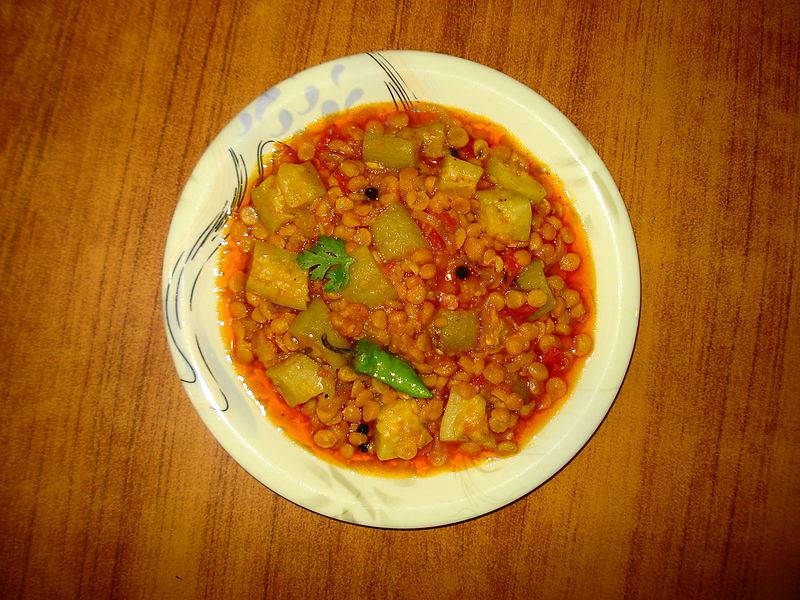
Ole Curry
Ingredients:
Ole/suran/jimikand (yam) 250 g
Salt ½ tsp
Lime juice 1 tbsp
Mustard oil
1 medium-sized onion
2 green chillies
Paste of 1 medium-sized onion, 10 garlic cloves and 1-inch ginger
2 bay leaves
2 dry red chillies
Whole cumin seeds 1 tsp
Desi ghee 1 tsp
Turmeric powder 2 tsp
Kashmiri red chilli powder 2 tsp
Cumin powder 1 tsp
Garam masala powder ½ tsp
Coriander powder 3 tsp
Black pepper powder ½ tsp
Salt to taste
Wash, clean, peel and cut yam into equal-sized square pieces. Use mustard oil on your hands while cutting it because it might get itchy in some cases. You could either marinate it with some salt and turmeric and leave it aside for a few minutes. Or bring a pan of water to boil and add the yam pieces, some lime juice and salt, and boil for 10 minutes, and then drain and let it dry.
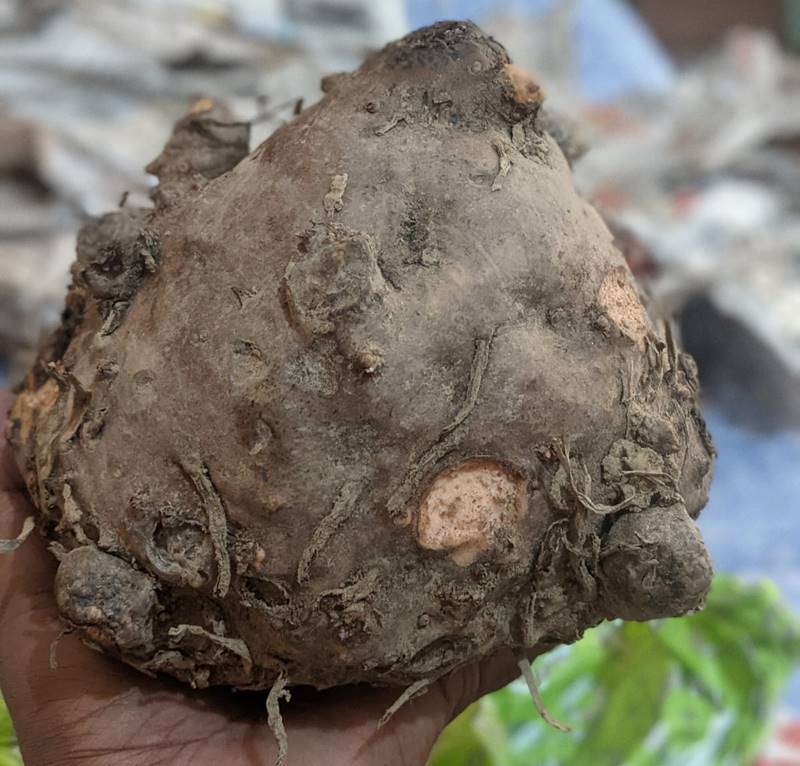
Shallow fry it in mustard oil. Once it changes colour to a golden brown, take these pieces out and keep them aside on a plate.
To prepare the curry, add bay leaves, dried red chillies, followed by onion. Once onion changes colour to a dark golden brown, then add paste of onion-ginger-garlic. Let it mix well so keep stirring. Then add the powdered spices and salt. Add a little water so that the spices cook well. Cover it with a lid, and leave it to simmer on low heat.
Once it is cooked, add a little more water, and when the mixture comes to a boil, add fried yam pieces, followed by garam masala powder. Cover the lid, and cook it for not more than two minutes.
You can roast cumin seeds in a small ladle, add ghee to it, and then pour it over the curry. It gives a nice flavour to the curry. Serve it with steamed rice.
Ole ki Chutney
Ole/suran/jimikand (yam) 250 g
Salt
Green chillies (finely chopped) 2
Yellow mustard (powdered) ½ tsp
Ginger (grated) 1 tsp
Garlic (finely chopped) 1 tsp
Carom seeds ½ tsp
Nigella seeds ½ tsp
Mustard oil 2 tbsp
Salt to taste
Wash, clean, peel and cut yam into equal-sized square pieces. Use mustard oil on your hands while cutting it because it might get itchy in some cases. Cook it in water and salt. Once it is done, drain water and let it dry.
Put other ingredients in a bowl, add boiled yam, and mix well. Add mustard oil and keep it in the sun. Store in an airtight container and it makes for a great winter addition to the meal.

Bachkas, Chhanuas and Pakodas (Fritters)
Vegetables – potato, eggplant, raw banana, peas, spinach leaves, and onion/garlic leaves, cauliflower
Gram flour
Rice flour
Water
Salt
Carom seeds
Paste of ginger-garlic-chilli
Mustard oil to deep fry
Potatoes, eggplant, and raw bananas are cut into thin round slices. A thick batter of gram flour with a dash of rice flour, ginger-garlic-chilli paste and salt is readied. The cut vegetables are dipped and then cooked on a tawa on low heat. When it changes colour to a deep golden brown, it is ready to be served. These are called bachkas.
Peas, spinach leaves, and onion/garlic leaves follow the same procedure but are deep-fried in oil and called chhanuas.
When vegetables, like potatoes, cauliflower, eggplant, etc, are dipped in a thin gram flour batter mixed with ginger-garlic-chilli paste and salt, and deep-fried, they are called pakodas.
So what are you preparing today – ole curry, chana dal-kaddu, or pakodas?

